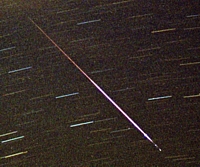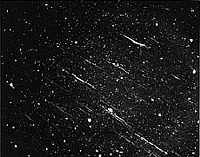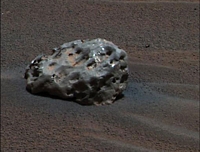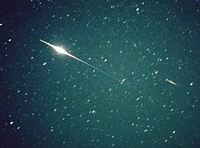Below are mentioned phenomena that have to do with some lights or “fires” visible in the sky. Here are some of the most spectacular sightings that an amateur can witness: comets, meteor showers and fireballs; But other sightings also fit into this category, this time due to human space exploration; Orbiting the Earth there are countless objects that human beings have placed there, and sometimes we are lucky enough to observe them.
[accordion title=”I. Meteors”]
 Meteors are dust particles in space (as small as a grain of sand or rice), which when crossing Earth's orbit, are intercepted and impact our atmosphere, burning completely as they pass through it. This process takes only a few seconds, but is usually bright enough to produce a flash visible from Earth. This makes for nice views of meteors streaking across the night sky, sometimes with long trails. On a typical clear night, around 5 meteors can be seen per hour. These dust particles mostly come from the remains of comets, which when passing near the Sun release a large amount of material in the form of meteoroids (dust particles). Meteors are often mistakenly called shooting stars, and a subclassification of them is meteor showers.
Meteors are dust particles in space (as small as a grain of sand or rice), which when crossing Earth's orbit, are intercepted and impact our atmosphere, burning completely as they pass through it. This process takes only a few seconds, but is usually bright enough to produce a flash visible from Earth. This makes for nice views of meteors streaking across the night sky, sometimes with long trails. On a typical clear night, around 5 meteors can be seen per hour. These dust particles mostly come from the remains of comets, which when passing near the Sun release a large amount of material in the form of meteoroids (dust particles). Meteors are often mistakenly called shooting stars, and a subclassification of them is meteor showers.
[/accordion]
[accordion title=”II. Meteor showers
 It is a phenomenon in which, during certain days of the year, the number of meteors visible in one night increases considerably. They occur because the Earth in its orbit crosses an area with abundant dust particles, which have been spread in the form of a trail by a comet; As our planet crosses that zone, it is possible to see between 20, 50, even more than 100 meteors per hour (in meteor storms even thousands can be seen per hour). The meteors appear to “come” from a particular region of the sky (the zone where the particles are scattered); this region is called radiant, and to help orient yourself in its location, the showers are called according to the constellation where the radiant is located (e.g. if it is in the constellation of Leo it is the Leonid shower; in that of Perseus, Perseids, etc.). The activity of a shower is “calibrated” by a standard measurement, called Zenital Hourly Rate (THZ) (number of meteors visible by an observer, in 1 hour, with ideal conditions and the radiant at the zenith).
It is a phenomenon in which, during certain days of the year, the number of meteors visible in one night increases considerably. They occur because the Earth in its orbit crosses an area with abundant dust particles, which have been spread in the form of a trail by a comet; As our planet crosses that zone, it is possible to see between 20, 50, even more than 100 meteors per hour (in meteor storms even thousands can be seen per hour). The meteors appear to “come” from a particular region of the sky (the zone where the particles are scattered); this region is called radiant, and to help orient yourself in its location, the showers are called according to the constellation where the radiant is located (e.g. if it is in the constellation of Leo it is the Leonid shower; in that of Perseus, Perseids, etc.). The activity of a shower is “calibrated” by a standard measurement, called Zenital Hourly Rate (THZ) (number of meteors visible by an observer, in 1 hour, with ideal conditions and the radiant at the zenith).
[/accordion]
[accordion title=”III. Comets”]
 They are widely known celestial bodies, due to their particular configuration: a bright body provided with a “line" either "hair“, which can be as long as 1 AU (distance from the Earth to the Sun). Comets are of great importance because they are made up of a wide range of rocky and organic material: some are essential for the emergence of life. These elements are arranged as an icy “crust” on its surface, which does not have a visible tail until it gets close enough to the Sun; At that moment, radiation and the solar wind cause the comet to release many tons of material in the form of dust and gas, forming the “tail”; This always points in the opposite direction to the Sun, because the tail is simply the material expelled or “pushed” by the solar wind. Comets usually have very long and elliptical orbits, causing them to return every few years and become visible again.
They are widely known celestial bodies, due to their particular configuration: a bright body provided with a “line" either "hair“, which can be as long as 1 AU (distance from the Earth to the Sun). Comets are of great importance because they are made up of a wide range of rocky and organic material: some are essential for the emergence of life. These elements are arranged as an icy “crust” on its surface, which does not have a visible tail until it gets close enough to the Sun; At that moment, radiation and the solar wind cause the comet to release many tons of material in the form of dust and gas, forming the “tail”; This always points in the opposite direction to the Sun, because the tail is simply the material expelled or “pushed” by the solar wind. Comets usually have very long and elliptical orbits, causing them to return every few years and become visible again.
[/accordion]
[accordion title=”IV. Meteorites”]
 They are small objects that, unlike a meteor, do not completely disintegrate when passing through the Earth's atmosphere, which is why they touch the surface, forming a crater. These have a size of less than 50 m, although it can be said that “large” meteorites are much rarer than small ones (only a few centimeters); Meteorites are much less frequent than meteors, due to the action of the atmosphere that destroys most meteoroid particles in a few seconds. Racing cars also fall into this category, described as “fireballs” with a large trail, which are seen for several seconds or minutes, and are usually accompanied by a roar/explosion, which destroys part of the meteor, while some fragments reach the surface and become meteorites, although without leaving a crater marked .
They are small objects that, unlike a meteor, do not completely disintegrate when passing through the Earth's atmosphere, which is why they touch the surface, forming a crater. These have a size of less than 50 m, although it can be said that “large” meteorites are much rarer than small ones (only a few centimeters); Meteorites are much less frequent than meteors, due to the action of the atmosphere that destroys most meteoroid particles in a few seconds. Racing cars also fall into this category, described as “fireballs” with a large trail, which are seen for several seconds or minutes, and are usually accompanied by a roar/explosion, which destroys part of the meteor, while some fragments reach the surface and become meteorites, although without leaving a crater marked .
[/accordion]
[accordion title=”V. Artificial satellites"]
 An artificial satellite, in the case of our planet, is any object placed in orbit around the Earth by human beings. This category includes satellites themselves (communications, military, scientific, climate, etc.), as well as other objects, such as International Space Station, the space shuttle or the Hubble space telescope. On a dark, clear night, an artificial satellite can be seen with the naked eye as a faint point that moves faster than the apparent movement of the stars; in fact, an artificial satellite can cover the entire celestial vault in ~5 minutes, and they are easily distinguishable compared to the stars. Objects like the Space Station or the space shuttle are much easier to observe, as long as they pass through the coordinates where you are.
An artificial satellite, in the case of our planet, is any object placed in orbit around the Earth by human beings. This category includes satellites themselves (communications, military, scientific, climate, etc.), as well as other objects, such as International Space Station, the space shuttle or the Hubble space telescope. On a dark, clear night, an artificial satellite can be seen with the naked eye as a faint point that moves faster than the apparent movement of the stars; in fact, an artificial satellite can cover the entire celestial vault in ~5 minutes, and they are easily distinguishable compared to the stars. Objects like the Space Station or the space shuttle are much easier to observe, as long as they pass through the coordinates where you are.
[/accordion]
[accordion title=”VI. Iridium flare”]
 Iridium is a type of communications satellite (66 in total) from the Motorola company put into orbit to provide mobile satellite communications; The main purpose of these satellites went bankrupt and they currently have military applications, but here they have a separate mention because, due to the configuration of their antennas, the Iridium satellites reflect the light of the Sun in a very powerful way, producing flashes that can reach Earth. between magnitude -4 to -7, which is highly bright (the magnitude of the planet Venus is -4). These brief but strong flashes are called Iridium flares. In addition to being curious to observe them (for which you can find out if any will transit our area), these satellites are frequently confused with UFOs.
Iridium is a type of communications satellite (66 in total) from the Motorola company put into orbit to provide mobile satellite communications; The main purpose of these satellites went bankrupt and they currently have military applications, but here they have a separate mention because, due to the configuration of their antennas, the Iridium satellites reflect the light of the Sun in a very powerful way, producing flashes that can reach Earth. between magnitude -4 to -7, which is highly bright (the magnitude of the planet Venus is -4). These brief but strong flashes are called Iridium flares. In addition to being curious to observe them (for which you can find out if any will transit our area), these satellites are frequently confused with UFOs.
[/accordion]

